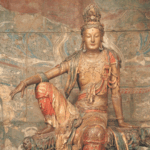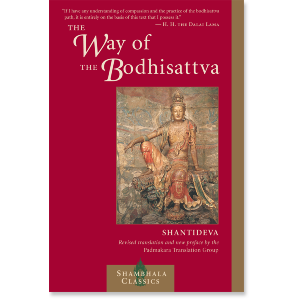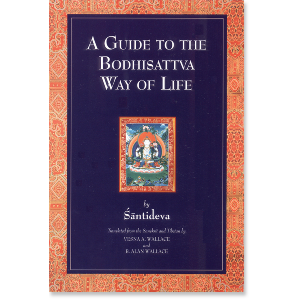The Story Behind the Bodhicharyavatara
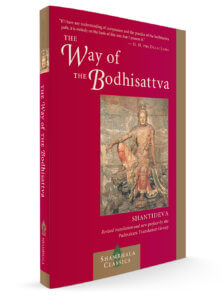
The text with the Sanskrit title Bodhicharyavatara (shortened from the longer Bodhisattvacharyavatara)—usually known in English as either The Way of the Bodhisattva or A Guide to the Bodhisattva’s Way of Life—is by far the best-known work attributed to the eighth-century Indian monk Shantideva. It would be impossible to adequately summarize its importance and impact in this small space, but what follows is a brief account of the origin of this classic that has come to be considered an indispensable guide for anyone on the Mahayana path.
Shantideva was born a prince in a kingdom located in the present-day Indian state of Gujarat. Moved by the Buddhist teachings—and by a vision of Manjushri—he renounced his royal inheritance and became a simple monk at Nalanda, that vast center of Buddhist learning that flourished for more than seven hundred years in what is today the state of Bihar, near the sites where the Buddha is said to have given many of the teachings recorded in the sutras.
As the story goes, some of his fellow monks observed that Shantideva seemed to spend his time doing nothing other than sleeping, eating, and wandering about. Judging him to be lazy or to be wasting the generosity of the monastery’s patrons, they hatched a plan to expel him: Every week at Nalanda a public teaching was given, usually by one of the senior monks. Thinking it would shame Shantideva into leaving, the monks requested that he give the weekly teaching. After declining their first few requests, to their surprise, he finally agreed. On the appointed day, he took his place on the teaching throne set up in front of the monastery. He asked those congregated if they would rather hear a well-known teaching or one they had never heard before. Curious, and perhaps hopeful at the prospect of Shantideva demonstrating his lack of knowledge and diligence in front of a large audience, they asked for a new teaching.
And so he began. We can imagine that his audience responded with incredulity, followed by humility, inspiration, and, ultimately, awe—for the astonishing words that came out of his mouth were the teaching we now know as The Way of the Bodhisattva. Many reported seeing Manjushri appear in the sky above Shantideva as he taught. When he reached the ninth chapter, on Transcendent Wisdom, both Shantideva and Manjushri ascended into the sky above and disappeared—though Shantideva’s voice continued to be heard as he completed his exposition.
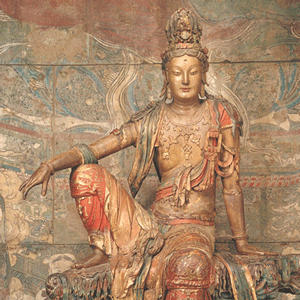 Members of the congregation, many of whom had extraordinary abilities of recollection, hurried to write down what they had heard, but their accounts varied, and this text was clearly so important that they were concerned about recording it faithfully. When, some time later word reached Nalanda that Shantideva was living in South India, several of the panditas set off to find him in order to confirm the definitive version. Shantideva not only identified the correct rendering of the text for them, he also alerted them to the existence of his other two texts, The Compendium of Sutras and The Compendium of Training, which they found in a place he indicated, hidden in a beam in his meditation hut back at Nalanda. Of these two, only the latter survives. However, several shorter versions of the Bodhicharyavatara were known about in Tibet. They have come to light from the eleventh-century Dunhuang cave manuscripts, rediscovered in the early twentieth century.
Members of the congregation, many of whom had extraordinary abilities of recollection, hurried to write down what they had heard, but their accounts varied, and this text was clearly so important that they were concerned about recording it faithfully. When, some time later word reached Nalanda that Shantideva was living in South India, several of the panditas set off to find him in order to confirm the definitive version. Shantideva not only identified the correct rendering of the text for them, he also alerted them to the existence of his other two texts, The Compendium of Sutras and The Compendium of Training, which they found in a place he indicated, hidden in a beam in his meditation hut back at Nalanda. Of these two, only the latter survives. However, several shorter versions of the Bodhicharyavatara were known about in Tibet. They have come to light from the eleventh-century Dunhuang cave manuscripts, rediscovered in the early twentieth century.
For well over a millennium now, Shantideva’s Way of the Bodhisattva has been revered and studied as a manual for the development of bodhicitta, the mind of awakening both in the aspiring and engaged forms of relative bodhicitta and absolute bodhicitta. Some of the results of that study can be found in the books below related to this text, a few of which also include further details of Shantideva’s exploits and teachings.
For a far more in-depth exploration of the history of the text, see the video from our Immersive Workshop—in particular the Overview and History session—as well as the first part of the following video in the series.

